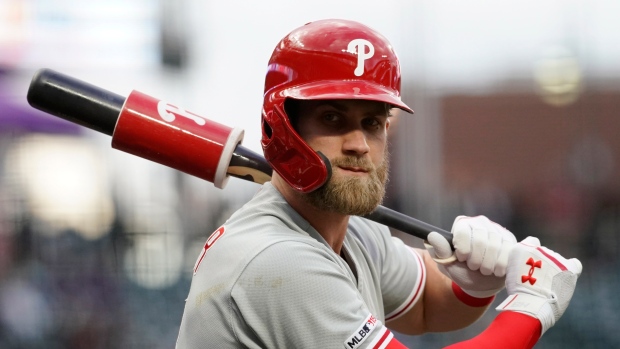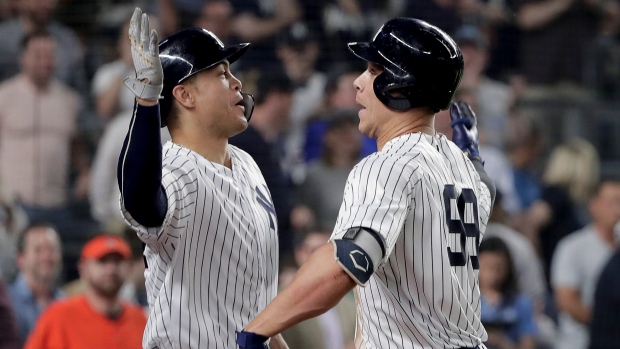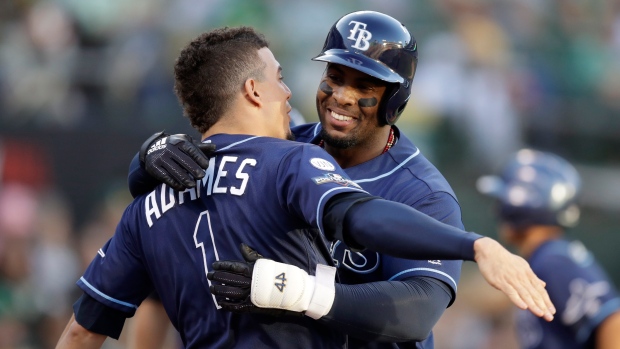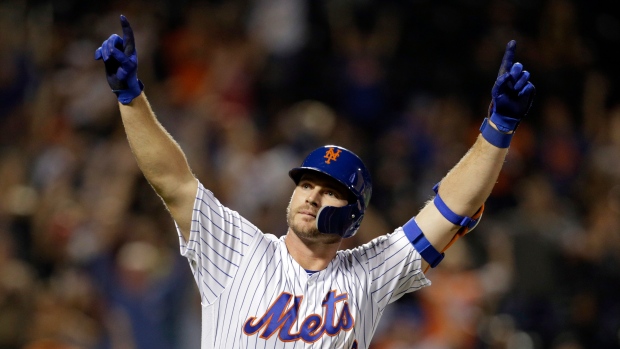Mar 28, 2020
Four big questions on what would have been opening weekend
As the COVID-19 pandemic continues to keep ballparks quiet and almost everyone in their homes, TSN.ca takes a peek at four burning questions around MLB for when the words “Play ball!” are finally shouted from behind home plate.

There’s two ways to keep baseball on the brain during what should have been opening weekend of the MLB season. Looking back on things that have already happened or looking ahead at what’s to come. The game we love will come back, but when is anybody’s guess.
As the COVID-19 pandemic continues to keep ballparks quiet and almost everyone in their homes, TSN.ca takes a peek at four burning questions around MLB for when the words "Play ball!" are finally shouted from behind home plate.
Can Judge, Stanton finally stay healthy?

When the New York Yankees acquired Giancarlo Stanton from the Miami Marlins in December 2017, it meant that two of the game’s best sluggers could very well hit back-to-back for the next five or 10 years in a hitter’s ballpark. For opposing pitchers, especially those in the notoriously tough American League East, the thought of facing Stanton and Aaron Judge in the same inning must have been a nightmare.
Judge was coming off one of the most impressive debut seasons ever, winning Rookie of the Year after putting up 52 home runs, 112 RBI and an OPS of 1.049. Pretty good.
Except Stanton was even better that season. The four-time All-Star hit 59 homers and drove in 132 on his way to the National League MVP Award. The duo was going to do damage, the only question was how much.
But it hasn’t been near as much as Yankee fans were hoping so far. After some pondered whether or not they could ever combine for 100 homers in a season, Judge and Stanton haven’t even reached that mark in their two years together in the Bronx. The explanation is simple – injuries.
Stanton’s debut season in 2018 was healthy as he finished with 38 longballs in 158 games, but the injury bug bit Judge hard. In late July, Judge was struck in the wrist by a pitch and suffered a fracture that kept him out until September, missing 50 games in total that season.
Last year was even worse, especially for Stanton. The former Marlin played only 19 games because of injuries to his bicep, shoulder and knee. Meanwhile, Judge sustained a strained oblique on April 20 and missed two months, finishing with 27 home runs and a large chunk of his season missing for the second straight year.
The Judge-Stanton pairing has been effective when healthy (Stanton .856 OPS in 2018 and 2019, Judge .920) but that’s been the issue. Who knows, maybe a shortened season in 2020 helps. With Gerrit Cole now in the fold and an ever-dangerous lineup around them, the Yankees could be a big, big problem (I was wondering if the word ‘threat’ might work better here) if their dynamic duo stays on the field.
Could the Rays actually win the AL East?

Over the past decade, the Tampa Bay Rays have been a solid organization. They’ve won 90-plus games six times and reached the playoffs four times, including last season after going 96-66.
As good as they’ve been, they haven’t had much to show for it. Since last winning the division in 2010, Tampa has seen the Boston Red Sox capture the AL East four times and the Yankees three, while they’ve finished either second or third in six seasons. Translation – usually good, rarely good enough.
But this year might be different, especially given the unpredictability of a shorter season.
The Rays don’t have a Mike Trout or a Judge, but they’re one of the most well-rounded teams in the big leagues.
The pitching staff led by Blake Snell, Charlie Morton and Tyler Glasnow is as nasty as it is effective. Snell won the 2018 Cy Young. Glasnow (1.78 ERA) could have won it in 2019 if he didn’t get hurt. Morton was third in voting last season after going 16-6 while striking out 11.1 per nine innings. Their bullpen led the Majors with a 3.66 combined ERA last season and most of their hard-throwing relievers are returning for 2020.
And then there’s the offence, which was middling last year but beefed up in the off-season. They added lots of power over the winter with the six-foot-six Jose Martinez, Japanese slugger Yoshitomo Tsutsugo and Hunter Renfroe, who launched 33 home runs last season playing in hitter-friendly Petco Park. The loss of Tommy Pham – probably their best all-around hitter – will sting, but their lineup is balanced enough to make up for it.
The consensus top prospect in baseball, Wander Franco, isn’t far away in their farm system, either.
How much pressure is on Bryce Harper?

When Bryce Harper signed his 13-year, $330 million contract with the Philadelphia Phillies last March, he said he was fully prepared for the Philly experience.
He sure got it.
Just one month into his Phillies’ tenure, Harper was booed by fans at Citizens Bank Park after a strikeout in an eventual 3-1 loss to the Detroit Tigers. Harper shrugged off the boos post-game (god help him if he didn’t) but it certainly wasn’t the last time he heard them from fans in the City of Brotherly Love.
By all accounts, Harper’s 2019 season was pretty good. Thirty-five home runs, a career-best 114 RBI and an OPS of .882 is pretty much market value for what the Phillies are paying. But Harper had his downsides, too, as he had a career-high 178 strikeouts and walked 31 fewer times than the season before. He also failed to make the All-Star Team for the first time in four seasons and looked shaky at times in right field. Still, it’s hard to call Harper’s 2019 stats disappointing.
Most troubling of all might be how the Phillies’ season went. After going from 66 wins in 2017 to 80 in 2018, Harper’s arrival was supposed to be the push over the top toward playoff baseball, which the city hasn’t seen since 2011. But the Phillies won just one more game last season and didn’t come all that close to October.
Fairly or unfairly, Harper shouldered lots of that blame, as did manager Gabe Kapler, who was fired after two seasons and is now with the San Francisco Giants. The good news for the former MVP is he has lots of time to help turn the Phillies around, 12 more years of it in fact. Except fans in Philly aren’t exactly the patient sort, either.
Will home run numbers keep climbing?

When Baltimore’s Jonathan Villar went deep off Dodgers righty Caleb Ferguson in a mid-September game at Camden Yards, it didn’t mean much for either team. Los Angeles was cruising to a first-place finish in the NL West and the Orioles were definitively destined as last in their division. Still, it had an impact in a different way.
Villar’s blast gave MLB its 6,106th home run of the season, breaking the previous record set two years ago. Teams finished with an astounding 6,776 longballs in 2019, well above any year at the height of the steroid era from the late 1990s to the mid 2000s.
Going into last year, the most home runs a team ever hit in a single season was 268. The Minnesota Twins reached that before August ended, finishing with 307. Three other teams – the New York Yankees (306), Houston Astros (288) and Los Angeles Dodgers (279) – easily passed the previous mark, too.
The what is easy to understand. The why? It’s less clear.
After years of questions about "juiced baseballs" purposely altered by MLB to create more offence, the league commissioned a study that found baseballs had less drag and inconsistent seam heights which both presumably led to more home runs.
But there’s probably another reason. As more analytical data became available over the last several years, teams realized that placing an emphasis on home runs tends to yield more aggregate offence than the old-fashioned rally, even if it does lead to more strikeouts.
The data agrees. Punchouts have increased in each of the last 13 seasons while total hits are well below what they were 10 years ago. Aggregate run producing, meanwhile? Way up. As league trends take hold, it’s no surprise hitters adjust their swings to stay current. How much increasing home run totals have to do with baseballs that have "less drag" or a change in personal approach is impossible to quantify.
With a shortened season on the horizon (we hope), the league won’t set a new home run number once again in 2020. But that doesn’t mean the trend won’t continue.

